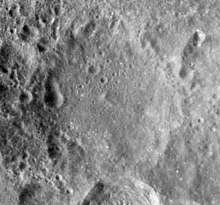Perepelkin (lunar crater)
Perepelkin is a lunar impact crater that is located just to the south of the similar crater Love. It was named after Soviet astrophysicist Yevgeny Perepyolkin.[1] Attached to the exterior of its southern rim is the smaller Shirakatsi. Less than one crater diameter to the east-northeast is Lane, and to the west-southwest are the co-joined Danjon and D'Arsonval.
 Apollo 17 Mapping Camera image | |
| Coordinates | 10.0°S 129.0°E |
|---|---|
| Diameter | 97 km |
| Colongitude | 231° at sunrise |
| Eponym | Yevgeny Perepyolkin |

The rim of this crater is relatively heavily eroded, and is similar in appearance to Love to the north. Along the western inner wall is an odd, pear-shaped crater that is probably a merge of two impacts. There is a short chain of small craterlets along the southwestern inner wall. The floor is pitted by tiny impacts, but is relatively level compared to the surrounding terrain. There is a small central peak at the midpoint that has a ridge extension to the southeast.
Satellite craters
By convention these features are identified on lunar maps by placing the letter on the side of the crater midpoint that is closest to Perepelkin.
| Perepelkin | Latitude | Longitude | Diameter |
|---|---|---|---|
| P | 12.4° S | 127.3° E | 25 km |
References
- "Perepelkin (lunar crater)". Gazetteer of Planetary Nomenclature. USGS Astrogeology Research Program.
- Andersson, L. E.; Whitaker, E. A. (1982). NASA Catalogue of Lunar Nomenclature. NASA RP-1097.CS1 maint: ref=harv (link)
- Bussey, B.; Spudis, P. (2004). The Clementine Atlas of the Moon. New York: Cambridge University Press. ISBN 978-0-521-81528-4.CS1 maint: ref=harv (link)
- Cocks, Elijah E.; Cocks, Josiah C. (1995). Who's Who on the Moon: A Biographical Dictionary of Lunar Nomenclature. Tudor Publishers. ISBN 978-0-936389-27-1.CS1 maint: ref=harv (link)
- McDowell, Jonathan (July 15, 2007). "Lunar Nomenclature". Jonathan's Space Report. Retrieved 2007-10-24.CS1 maint: ref=harv (link)
- Menzel, D. H.; Minnaert, M.; Levin, B.; Dollfus, A.; Bell, B. (1971). "Report on Lunar Nomenclature by the Working Group of Commission 17 of the IAU". Space Science Reviews. 12 (2): 136–186. Bibcode:1971SSRv...12..136M. doi:10.1007/BF00171763.CS1 maint: ref=harv (link)
- Moore, Patrick (2001). On the Moon. Sterling Publishing Co. ISBN 978-0-304-35469-6.CS1 maint: ref=harv (link)
- Price, Fred W. (1988). The Moon Observer's Handbook. Cambridge University Press. ISBN 978-0-521-33500-3.CS1 maint: ref=harv (link)
- Rükl, Antonín (1990). Atlas of the Moon. Kalmbach Books. ISBN 978-0-913135-17-4.CS1 maint: ref=harv (link)
- Webb, Rev. T. W. (1962). Celestial Objects for Common Telescopes (6th revised ed.). Dover. ISBN 978-0-486-20917-3.CS1 maint: ref=harv (link)
- Whitaker, Ewen A. (1999). Mapping and Naming the Moon. Cambridge University Press. ISBN 978-0-521-62248-6.CS1 maint: ref=harv (link)
- Wlasuk, Peter T. (2000). Observing the Moon. Springer. ISBN 978-1-85233-193-1.CS1 maint: ref=harv (link)
External links
| Wikimedia Commons has media related to Perepelkin (lunar crater). |